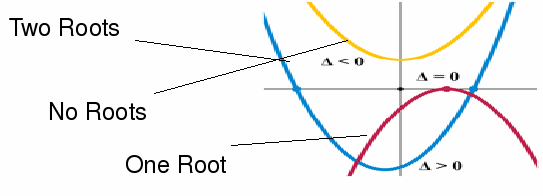In general a quadratic curve may have one, two or no roots, as shown.

For the curve![]() the number of roots depends entirely on the discriminant
the number of roots depends entirely on the discriminant![]()
If![]() there are no roots.
there are no roots.
If![]() there is one root.
there is one root.
If![]() there are two roots.
there are two roots.
We are typically asked: Find the set of values of![]() for which the curve
for which the curve![]() has
has
no roots:![]()
![]() always, for every value of
always, for every value of![]() so for every value of k the curve has two roots.
so for every value of k the curve has two roots.
Example: Find the set of values of![]() for which the curve
for which the curve![]() has two roots.
has two roots.
We solve for![]()
![]() So solutions exist for all values of
So solutions exist for all values of![]()
Example: Find the set of values of![]() for which the curve
for which the curve![]() has one root.
has one root.
We solve for![]()
![]()
So![]() or
or![]()
